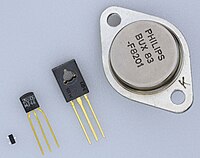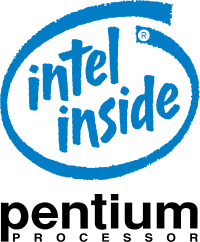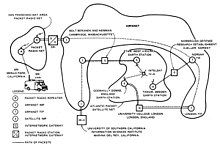-
Use Cases
-
Resources
-
Pricing
Early Computing
Invention of the Analytical Engine
Oct 23, 1834
% complete
Charles Babbage conceptualizes the Analytical Engine, an early mechanical computer designed to perform general-purpose computations.
Image source: Analytical engine

Invention of the Telegraph
May 24, 1844
% complete
Samuel Morse successfully demonstrates the telegraph, a revolutionary communication system that allows the transmission of information through electrical signals over long distances.
Image source: Telegraphy

ENIAC Completion
Dec 10, 1945
% complete
The Electronic Numerical Integrator and Computer (ENIAC), the world's first general-purpose electronic digital computer, is completed at the University of Pennsylvania.
Image source: ENIAC

Computer Hardware
Invention of the Transistor
Dec 23, 1947
% complete
Scientists John Bardeen, Walter Brattain, and William Shockley invent the transistor, a small semiconductor device that revolutionizes the field of electronics and paves the way for modern computers.
Image source: Transistor

Introduction of UNIVAC I
Mar 31, 1951
% complete
The UNIVAC I, the world's first commercial computer, is unveiled and installed at the United States Census Bureau.
Image source: UNIVAC I

Development of Integrated Circuits
Sep 12, 1958
% complete
Jack Kilby and Robert Noyce independently invent the integrated circuit, a compact electronic circuit that combines multiple transistors on a single chip, leading to significant advancements in computer technology.
Image source: Integrated circuit

First Commercial Microprocessor
Nov 15, 1971
% complete
Intel releases the Intel 4004 microprocessor, the world's first commercially available microprocessor, marking a milestone in the miniaturization of computers.
Image source: Microprocessor

Apple I Release
Apr 1, 1976
% complete
Steve Wozniak and Steve Jobs create the Apple I, the first computer released by Apple Inc., laying the foundation for the future of personal computing.
Image source: Apple I

IBM PC Release
Aug 12, 1981
% complete
IBM introduces the IBM Personal Computer (PC), which sets the standard for personal computers and establishes IBM as a major player in the computer industry.
Image source: IBM Personal Computer

Introduction of Pentium Processors
Mar 22, 1993
% complete
Intel releases the Pentium processors, delivering significant performance improvements and setting the standard for microprocessor technology in personal computers.
Image source: Pentium

Introduction of USB Standard
Jan 1, 1996
% complete
The Universal Serial Bus (USB) standard is introduced, providing a versatile and widely adopted interface for connecting peripherals to computers.
Image source: USB

Introduction of Wi-Fi
Sep 30, 1999
% complete
The Institute of Electrical and Electronics Engineers (IEEE) releases the first Wi-Fi standard (802.11), enabling wireless internet connectivity and widespread adoption of wireless networks.
Image source: Wi-Fi

Introduction of iPod
Oct 23, 2001
% complete
Apple unveils the iPod, a portable media player that revolutionizes the way people listen to music and shapes the future of portable entertainment devices.
Image source: IPod

Introduction of iPhone
Jun 29, 2007
% complete
Apple unveils the iPhone, a revolutionary smartphone that combines a mobile phone, internet capabilities, and a touchscreen interface, transforming the mobile industry.
Image source: IPhone

Computer Software
Creation of FORTRAN
Aug 15, 1956
% complete
Developed by IBM, the Fortran programming language is introduced, becoming the first high-level programming language and a key tool for scientific and engineering computing.
Image source: Fortran

Introduction of COBOL
Jan 1, 1960
% complete
The Common Business-Oriented Language (COBOL) is developed to meet business data processing needs, becoming one of the most widely used programming languages in history.
Image source: COBOL

Introduction of UNIX
Nov 3, 1971
% complete
The UNIX operating system, developed by a team at Bell Labs, is released, becoming one of the most influential and widely used operating systems in the history of computing.
Image source: Unix

Introduction of TCP/IP
Jan 1, 1983
% complete
The Transmission Control Protocol/Internet Protocol (TCP/IP) is adopted as the standard communications protocol for the internet, enabling global connectivity and the foundation of modern networking.
Image source: Internet protocol suite

Development of World Wide Web
Mar 12, 1989
% complete
Tim Berners-Lee proposes the World Wide Web (WWW), a system of interconnected hypertext documents accessible via the internet, revolutionizing information sharing and communication.
Image source: World Wide Web

Microsoft Windows 3.0 Release
May 22, 1990
% complete
Microsoft launches Windows 3.0, a highly successful version of its graphical user interface (GUI) operating system, introducing features like multitasking and improved graphics capabilities.
Image source: Windows 3.0

Creation of Java Programming Language
May 23, 1995
% complete
James Gosling and his team at Sun Microsystems create the Java programming language, known for its platform independence and widespread use in web and software development.
Image source: Java (programming language)

Release of Google Search Engine
Sep 4, 1998
% complete
Larry Page and Sergey Brin launch Google, a revolutionary search engine and the foundation of a tech giant that would dominate the internet industry.
Image source: Google Search

Release of Windows XP
Oct 25, 2001
% complete
Microsoft launches Windows XP, a highly popular and influential operating system that introduces a more stable and user-friendly experience.
Launch of Facebook
Feb 4, 2004
% complete
Mark Zuckerberg, along with his college roommates, creates Facebook, the world's largest social networking platform with billions of users worldwide.
Release of Windows 10
Jul 29, 2015
% complete
Microsoft launches Windows 10, a widely praised and versatile operating system that features a more unified user experience across devices and introduces new functionalities.
Key Facts
- The earliest known computing devices date back to ancient civilizations, such as the abacus and the Antikythera mechanism.
- The invention of the mechanical calculator by Blaise Pascal in the 17th century marked a significant milestone in the development of computing devices.
- The Analytical Engine, conceptualized by Charles Babbage in the 19th century, is considered the precursor to modern computers.
- The invention of the transistor in 1947 revolutionized computing technology, paving the way for smaller, more efficient computers.
- The introduction of personal computers in the 1970s and 1980s democratized computing, making it accessible to individuals and businesses.
Source
This History of Computers timeline was generated with the help of AI using information found on the internet.
We strive to make these timelines as accurate as possible, but occasionally inaccurates slip in. If you notice anything amiss, let us know at [email protected] and we'll correct it for future visitors.
Create a timeline like this one for free
Preceden lets you create stunning timelines using AI or manually.
Customize your timeline with one of our low-cost paid plans
Export your timeline, add your own events, edit or remove AI-generated events, and much more
Free
$
0
free forever
No credit card required.
Basic
$
10
/month
billed annually
Cancel anytime.
Pro
$
16
/month
billed annually
Cancel anytime.
Common Questions
Can I cancel anytime?
Yes. You can cancel your subscription from your account page at anytime which will ensure you are not charged again. If you cancel you can still access your subscription for the full time period you paid for.
Will you send an annual renewal reminder?
Yes, we will email you a reminder prior to the annual renewal and will also email you a receipt.
Do you offer refunds?
Yes. You can email us within 15 days of any payment and we will issue you a full refund.
What if I have more questions?
Check out our pricing docs or send us an email anytime: [email protected].